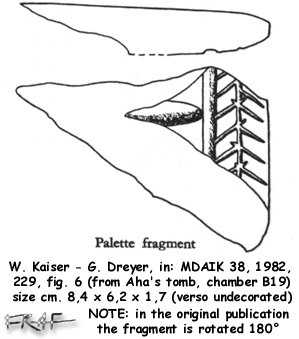|
|
|
|
|
|

Description
Abydos B19 palette fragment
Abydos, cem.
B, chamber B19 of Aha's complex
(for size see above)
Bibliography
W. Kaiser - G. Dreyer, in: MDAIK 38, 1982, 228, fig. 6
(the orientation in the MDAIK figure is the one shown on the right >)
This important fragment has a known provenance and archaeological context. Together with the Minshat el Ezzat palette, it attests that this category of decorated objects was still valued and manufactured in the early and middle part of the First Dynasty. But the complex animal decorations were parhaps abandoned after the reign of Narmer.
I have reconstructed a few possible outlines of the palette; the palette could be much earlier than Aha's reign (an heirloom), but according to my most probable reconstruction it could also be an early First Dynasty product..
Initially I had thought that the vertical frame along the edge of the palette could be a lycaon or another animal tail.
I had drawn a first raw reconstruction of the palette with a serekh of Aha and a mammal of which I have exaggerated the tail size to show the relief. However it is highly improbable that such a palette type would still be manufactured in Aha's (and in his immediate predecessors') reign.
Furthermore such a complex pattern for a tail is unknown on other palettes and fragments (the bushy tail is generally rendered with a simple series of horizontal strokes) [cf. fig. at page bottom and H.G. Fischer, in: Artibus Asiae 21, 1958, fig. 18].
In the original orientation (with V-shaped pattern) the motif could also represent a plant (palm tree trunk ?), but these are generally in the central part of the palettes with the exception of the Minshat el-Ezzat palette (where the palm is on the right side although not on the very edge of the palette); however also the depiction of the trunk is generally different from the present motif.
A similar feature recalls the serpopards' necks as well, but even in this case their long necks are never found framing the edge of the palettes (see the images below).
Perhaps the different pattern used in this palette could depend on the later (?) date of the object or on the different animal (than lycaon) which was carved on it.
But as I have anticipated, I don't think that this fragment belongs to the type of palettes with carved animals reliefs.
Another possible (remote ?) explanation of the motif could be that of the edge of a reed and matwork shrine, represented as those on LP and ED seal impressions (cf. this early example in the figure: from Naga ed-Der tomb 7304, Naqada IId period, after H. Kantor, JNES 11, 1952, pl. 25B). Despite the example on the Hunters palette (and the occurrences on Metropolitan Mus. and Oxford Mus. knife handles), there aren't further representations of such structures on palettes; yet I think that buildings could have been originally shown on palettes with rows of human figures (processions) such as the fragments of the Brooklyn-Cairo, the 'Beirut' and the 'Warrior' palettes. These artifacts must date later (Naqada IIIA-B) than the decorated ivory knife handles from Abydos U cemetery.
NOTE: For early seal and seal impressions cf. R. Boehmer, Das Rollsiegel im prädynastischen Ägypten, in: Arch. Anzeig. 4, 1974, 495ff.; P.V. Podzorski, in: JNES 47, 1988, 259ff.; W. Kaiser, Zur Entstehung des gesamtagyptischen Staates, in: MDAIK 46, 1990, 287-299; U. Hartung, Pradynastische Siegelabrollungen aus dem Friedhof U in Abydos (Umme el Qaab), in: MDAIK 54, 1998/ 187-217; id., in: SÄK 26, 1998, 35-50.
 LINK to the Petrie Museum page |
In my opinion, the most striking similarity of the
motif found on the Aha tomb fragment (the horizontal stroke could perhaps
be a break) is found on the decorated edge of some Late Predynastic
rectangular palettes as the specimen in UC (73138) in the figure on
the left (from the cemetery of Naqada) and in UC 15832 (fig. below =
Petrie, 1920, pl. 44, 98W).
This motif is far less frequent than that of the parallel incised lines,
but nonetheless it appears along with a series of further edge-decorations,
on the LP/ED rectangular palettes (as on the Neith
palette).
Given the straight edge of the B19 fragment and the date of Aha's burial, it'd be possible that our fragment belongs to such a kind of simply shaped rectangular palettes, which have been frequently found in late Naqada IIIB- early Naqada IIIC (élite) cemeteries of Lower Egypt, as Tarkhan (esp. SD 77-79), Minshat Abu Omar as well as in many tombs of the Upper Egyptian necropolis of Naqada. Yet I find it somewhat unlikely for a royal tomb to be provided with such a standard type of cosmetic palette generally reserved to the individuals buried in élite or middle classes tombs and cemeteries. |

LINK
to the Petrie Museum page
*** *** ***
The rendering of some decorative motifs found on Naqada III palettes

Francesco Raffaele, May 21, 2003
